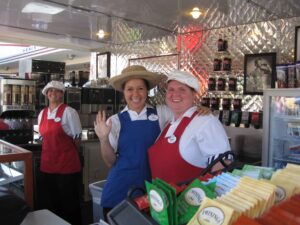
Something that strikes most visitors to Walt Disney World is how “nice” of a place it is. It’s very clean. The employees are called “cast members” because they’re playing a role and they have a reputation for great service and friendliness. Everyone knows that.
But there’s another unique element present at Disney World that is seemingly beyond the control of the Mouse. The guests at Disney World seem to be more well-behaved, happier, and positive than guests at other places of business and entertainment. Most of us probably attribute this to the cleanliness and friendliness of Disney and its staff. But there is something else at play.
If you have been through a Group Dynamic session or you’ve been a follower of this blog, you are familiar with the “behavior-outcome” statement. (Here are some posts to review: Effective Feedback is About the Future, Attitude is NOT Everything) the staff at Disney—the cast members—use behavior-outcome statements also. All the time. Two examples:
“Please move all the way down, filling in all available space–front to back and left to right–to make room for everyone.” At a lot of places where people need to make room like this, instruction usually goes like this: “Squeeze in, people.” And most people would probably sort of comply. But the Disney version offers the outcome (to make room for everyone) and that gives people a reason why. Further, the command itself begins the pleasantry, “please,” and is also very specific. Specific behavior + polite words + reasonable outcome = willing cooperation.
Some attractions start with a pre-show. This creates the great illusion that your experience is started– even when it hasn’t. In one case (Ellen’s Energy Adventure), there’s a short film shown in a large carpeted open space. On a hot day, before the film started, I sat down on the floor. Mara (my daughter) laid on the floor beside me with her head on my knee and Julie (my wife) laid down on the floor in the other direction with her head on my other knee. It was a lovely family moment, but it was soon shattered by the cast member’s announcement:
“If you are laying or sitting on the floor, please stand up. We need to make room for anyone else who comes in, and anyone who comes in will be entering a dark room from the bright outside, so you know, they might step on you. So, please stand for the whole 8 minute pre-show.” In other places, a staff member would likely make an announcement like “Stand up everybody. No sitting or laying down in here.” But the Disney way involved the specific behaviors, and the specific reason why, along with a bonus; we were told exactly how long we would be standing. Despite the pleasant comfort of our position, we cheerfully obeyed.
Next time you go to Disney World, watch for this. It is a great example of front-line employees, or organization members, exhibiting leadership behaviors.
If people at the lowest level of an organization (front-line employees) can motivate people outside of the organization (guests) with proactive communication that focuses on behavior, imagine how effective it can be if such an approach becomes the norm in your organization, and for you as a leader.
It can be magic.

Sally Wilke
Yet another good one! Keep ’em coming.